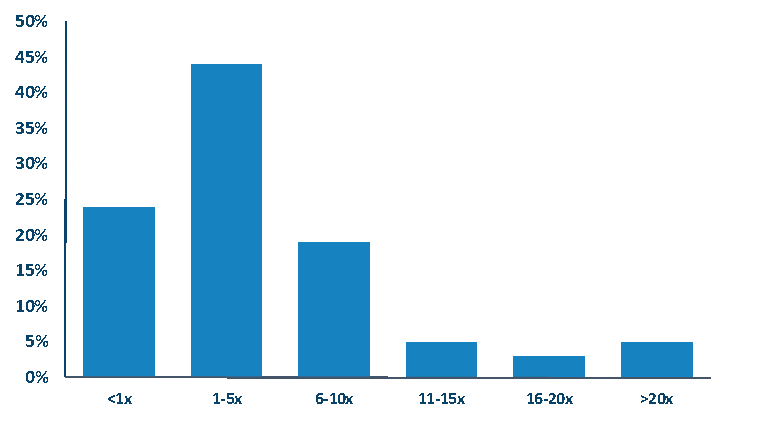Matthew Cushen, Co-founder of Worth Capital, looks at the rise of SEIS and the returns on offer.
Equity investing in early stage start-up businesses is becoming an increasingly common component of a diversified portfolio. The generous tax reliefs available from the Seed Enterprise Investment Scheme (SEIS) are the most oft quoted benefit of seed investing. But this is only one part of the equation.
There is also emerging data to illustrate a healthy return on investment and unlike many financial products, this is one that clients get excited about – following the fortunes of ‘their’ start-ups and sharing stories about investing in real businesses.
The big picture
The normal rules of business have changed and it’s nimble entrepreneurs that are challenging the old order and being the catalyst for our disruptive age. It’s start-ups that are creating new consumer behaviours and leading a recovering economy.
Start-ups are usually unencumbered by the deeply entrenched thinking and bureaucratic shackles that stifle large businesses. They have recently started to enjoy some of the advantages that used to only come with scale, for example:
- the cost of entry for a start-up is rapidly decreasing – a retailer can create an online shop window for almost nothing, and an app can be built for less than £5,000
- social media allows a new entrepreneur to interact with their consumer, grow a brand and make it personal and relevant to a precise audience, all at low cost
- entrepreneurs now can think globally from day one – selling in multiple markets and sourcing from multiple markets
Large businesses now routinely buy start-ups as a preferred route to get hold of new technology, products and services. Whilst we might immediately think of Google’s venture arm, many older ‘legacy’ businesses, such as Kelloggs, Campbells and Amex, also now have venture funds. One of the most active businesses is Unilever and in the last few months their deals have ranged from putting in £500,000 alongside a crowdfunding round for the on-demand beauty service Blow, to speeding $1 billion buying out Dollar Shave Club.
Driving growth
The need for fast growing start-ups to contribute to the overall health of our UK economy is heightened by Brexit created uncertainty.
The Octopus High Growth Small Business Report 2015 finds that one in three new jobs and 20% of economic growth are created by ‘high growth small businesses’ that make up less than 1% of UK businesses and make up less than 3% of the UK economy.
This growth is not just the preserve of London and the South East. It is creating opportunities across the UK – with nearly three in five of these growth businesses based beyond London and the South East, with 70% of turnover being out of London.
These are just some reasons that the UK government has been supportive of small business and start-ups. One of Theresa May’s earliest speeches on becoming Prime Minster was to emphasise her government’s commitment to supporting and listening to smaller businesses.
“I want to build an economy that works for all, and that means working with, and listening to, smaller firms.”
Teresa May, Prime Minister
Part of the government’s support, for the last couple of decades, has been to create tax incentives for investors that support early stage seed investing.
The Seed Enterprise Investment Scheme
The EIS was set up in 1994 and continued to be supported through Labour governments. It has since been made more attractive by the Conservative government, and has established itself as a part of tax legislation that neither of the main parties would be likely to compromise.
SEIS, established in 2012, is an extension of EIS and offers even more generous reliefs as an incentive for investors in very early stage businesses.
In the 2014/15 tax year, 2,185 companies raised £168 million through SEIS, growth from 1,995 companies and £148 million in funding in 2013/14.
But it can’t be a growing source of funding without a growing and enthusiastic body of investors. SEIS is becoming an established part of a sophisticated investor’s portfolio and a growing number of IFAs and wealth managers are including SEIS funds in their recommendations to clients. A survey by the EIS Association found that 14% of advisers already recommended SEIS investments and 61% of all advisers expected their use of SEIS (and EIS) to increase over the next year.
Tax advantages for investors
Often it is the tax reliefs that first catch the eye for potential SEIS investors – reliefs that reduce risks and increase return on investment.
Within some criteria, a company can raise £150,000 in funding covered by SEIS reliefs.
An individual investor can make multiple SEIS investments up to £100,000 per annum, qualifying for:
- 50% income tax relief: claimed back through self-assessment in the tax year following the investment or ‘carried back’ and claimed immediately against the previous tax year
- 100% capital gains exemption: gains upon exit, after a three year qualifying period, are tax free
- 50% capital gain re-investment relief: capital gains may be reinvested in SEIS to achieve re-investment relief, restricted to half of the gains realised
- loss relief: should a company fail the net investment (total minus the income tax relief) is multiplied by your tax rate and reclaimed from income tax
- 100% inheritance tax relief: provided that investments are held at the time of death and have been held for two years
For an investor with capital gains and a higher rate income tax liability, the total available reliefs can cover 84% of the investment – only 16% of their investment is at risk
HMRC publishes comprehensive guides to the rules around SEIS on its website.
Healthy returns
Reliefs should not be a reason to invest or to recommend an investment. A much more compelling rationale are the potential returns that are available. A recent report illustrated the returns from seed investing showing that while it may be high risk, a portfolio can still deliver healthy returns.
The Enterprise Research Centre (ERC), in conjunction with the UK Business Angels Association, published A Nation of Angels, in January 2015 – research completed through direct interviews with 403 business angels and 28 angel syndicates representing 8,000 angels. It found:
- 45% of angels reported that their investee businesses showed ‘high growth’ while 64% had investments showing ‘reasonable growth’.
- 60% of angels reported that they have experienced a positive (full or partial) exit since their first investment.
- 79% of them said they would re-invest their gains in further small business investment opportunities – only 7% said they would not.
It found that angels reported a lower rate of low returns and a higher rate of expected higher returns than in previous research – showing confidence in the market and the performance of their seed investments.
When asked about the growth status of their current portfolio, angels reported that 19% of their investee businesses showed ‘high growth’ while 34% of their investments showed ‘reasonable growth’. (The authors of the study did not define ‘high growth’ and ‘reasonable growth’ but left them subjective.)
Expected returns on investments made since January 2012:

When asked about their expectations of their returns from their portfolio of investments made since January 2012, investors expected that 76% of their investments would yield a positive return, of which 19% of their investments would yield a 6 to 10 times return and 13% of their investments would yield more than 10 times return.
Real growth stories
When have you ever heard someone discussing their pension at a dinner party? Or explaining their ISA to their grandkids? While many investment products can struggle to capture the imagination, investing in early stage businesses creates pride and a rich source of stories. Following a business as it grows (the triumphs and disasters) is part of the joy for investors. It is also a valuable way for advisers to stay genuinely engaged with their clients.
Considerations for reducing risk & increasing returns
There are several ways to make SEIS investments, for example as an individual business angel or as a consortium of angels; through crowdfunding or through subscribing to a fund. Useful questions when considering SEIS investments are:
- how can I construct a portfolio of several investments across companies and sectors?
- how can I get access to many potential investments then efficiently distil the best choices?
- how can the selection criteria increase the proportion of successful businesses and reducing failures?
- how realistic are the valuations?
- how are the start-ups being helped to reduce risk, accelerate growth and achieve maximum value?
At Worth Capital we have been investing in seed stage start-ups well before the advent of SEIS. Our experience in answering these questions has led us to a model which we believe ‘stacks the odds’ of seed investing. We have created the Start-Up Series – a competition format from which every month we distil the brightest of the UKs entrepreneurs with the smartest ideas. Our partners, Amersham Investment Management, are fund managers for the Start-Up Series SEIS Fund One which will invest in the winning businesses. We’d love to explain more and share our passion for seed investing. Please get in touch or visit our website – worthcapital.uk.














